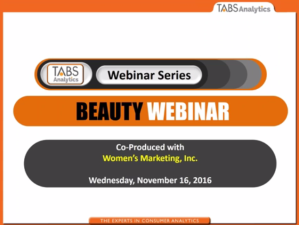Millennials, Hispanics, Driving Beauty Sales: TABS Analytics 11/21/2016
Millennial and Hispanic women are the heaviest buyers of cosmetics and skincare products in this $25 billion dollar market, according to Shelton, Ct.-based TABS Analytics’ Third Annual Beauty Study. Millennial women (ages 18-34) accounted for about 33 percent of the user base for cosmetics and skincare and almost 50 percent of heavy buyers of both categories (defined by the number product types of each category purchased).
“Millennial and Hispanic women are the clear drivers in the beauty market and account for almost 60 percent of all sales,” said Dr. Kurt Jetta, CEO and founder of TABS Analytics. “The beauty and consumer packaged goods industries need to take note of these buyers including the changes in the brands they are buying and how they are being influenced.”
Over the last three years, there has been a sharp rise in the amount of cosmetics purchased by Hispanic women and they now account for 15 percent of all category buyers, 24 percent of all heavy buyers of cosmetics, and 20 percent of heavy skincare buyers. The skew in purchasing toward high income purchasers continued, but the study showed a dip in purchasing after the $99,000 per year in earnings mark.
TABS Analytics’ Third Annual Beauty Study was developed to determine what types of beauty products consumers are buying, where those products are purchased, and what social media channels are influencing beauty consumers. One thousand geographically and demographically dispersed female consumers between the ages of 18 and 75 were surveyed for this study in October 2016. The study analyzed the importance of the various shopping channels, including department stores, specialty cosmetic and beauty stores, drug stores and grocery stores. The study also compares Internet and in-home purchases with those of traditional mass-market retailers.
Here are a number of key findings from the study:
YouTube, beauty bloggers, Facebook, and Instagram are top influencers for heavy beauty buyers.
Beauty blogs held steady as being important to 29 percent of all heavy buyers. Facebook tied with Instagram in having the second biggest increase in influence with Facebook, jumping from 17 percent in 2015 to 25 percent in 2016 among heavy buyers. Instagram increased in importance with heavy buyers from 19 percent in 2015 to 22 percent in 2016. One third of consumers also reported that online reviews influence their choices.
Winners in 2016 tended to be in mass market, with Walmart reasserting its market leading position in Beauty sales.
Target, CVS, Macy’s and Nordstrom slip.
Online sales bounced back.
Almost fifty percent of retail dollars are in the non-mass market channels, but share is down slightly from 2015.
Newer brands are gaining in awareness and picking up growth.
Category dynamics for skincare are very similar to cosmetics.
Offering good deals is the top factor in driving consumer outlet preference.
The beauty advisor model is becoming obsolete.
“The beauty category has maintained healthy growth in 2016, but that growth decelerated somewhat from our last study,” commented Dr. Jetta. “If these studies tell us anything, it is that there is still an insatiable demand for these younger users to directly engage with the products in terms of active research and trial of new products as well as new brands. Unlike most categories where we tend to see a shakeout of smaller brands, the pie of brand seems to be getting much bigger in beauty.”
About TABS Analytics
Operating since 1998, TABS Analytics, formerly TABS Group, based in Shelton, Conn., is a technology-enabled analytics firm. Its mission is to simplify and improve the way analytics are conducted in the consumer products industry.

